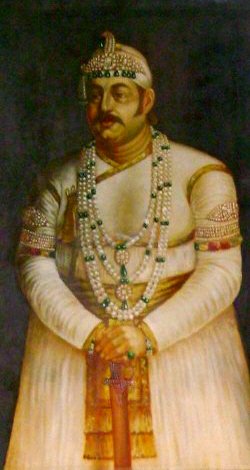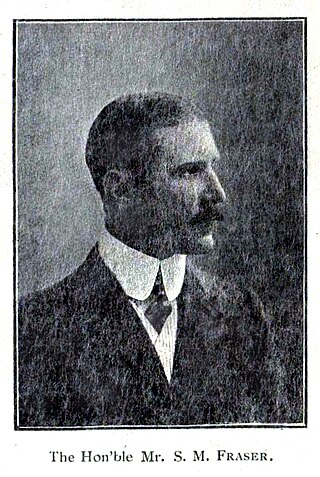Related Research Articles

Hyderabad State was a princely state under the British Raj in the south-central Deccan region of India with its capital at the city of Hyderabad. It is now divided into the state of Telangana, the Kalyana-Karnataka region of Karnataka, and the Marathwada region of Maharashtra in present-day India.

Nizam of Hyderabad was the title of the ruler of Hyderabad State. Nizam is a shortened form of Niẓām ul-Mulk, which means Administrator of the Realm, and was the title bestowed upon Asaf Jah I when he was appointed Viceroy of the Deccan by the Mughal Emperor Farrukhsiyar. In addition to being the Mughal Viceroy (Naib) of the Deccan, Asaf Jah I was also the premier courtier of the Mughal Empire until 1724, when he established the independent monarchy of Hyderabad and adopted the title "Nizam of Hyderabad".

Asaf Jah VI, also known as Sir Mir Mahboob Ali Khan Siddiqi, was the ninth Nizam of Hyderabad. He ruled Hyderabad State, one of the princely states of India, between 1869 and 1911.

Mir Osman Ali Khan, Asaf Jah VII was the last Nizam (ruler) of the Princely State of Hyderabad, the largest state in the British Indian Empire. He ascended the throne on 29 August 1911, at the age of 25 and ruled the State of Hyderabad between 1911 and 1948, until India annexed it. He was styled as His Exalted Highness (H.E.H) the Nizam of Hyderabad, and was widely considered one of the world's wealthiest people of all time. With some estimates placing his wealth at 2% of U.S. GDP, his portrait was on the cover of Time magazine in 1937. As a semi-autonomous monarch, he had his mint, printing his currency, the Hyderabadi rupee, and had a private treasury that was said to contain £100 million in gold and silver bullion, and a further £400 million of jewels. The major source of his wealth was the Golconda mines, the only supplier of diamonds in the world at that time. Among them was the Jacob Diamond, valued at some £50 million, and used by the Nizam as a paperweight.

Mahabubnagar district is a district in the Indian state of Telangana. Mahabubnagar is the district headquarters which is popularly known as Palamoor. The district shares boundaries with Narayanapet, Vikarabad, Rangareddy, Nagarkurnool, Wanaparthy and Jogulamba Gadwal districts. The district was formed during the period of the 6th Nizam of Hyderabad State – Nawab Mir Mahbub Ali Khan and hence named after him.

Mir Farqunda Ali Khan commonly known as Nasir-ud-Daulah, was seventh Nizam of Hyderabad, a princely state of British India, from 24 May 1829 until his death in 1857.

Afzal ad-Dawlah, Asaf Jah VMir Tahniyat Ali Khan Siddiqi was the eighth Nizam of Hyderabad, India, from 1857 to 1869.
Nawab Sir Ahmed Hussain, Amin Jung Bahadur, KCIE, CSI, LLD (Osmania), MA, BL (Madras) was born in Madras on 11 August 1863 in the family of a leading businessman.

Sir Mir Turab Ali Khan, Salar Jung I,, known simply as Salar Jung I, was an Indian nobleman who served as Prime Minister of Hyderabad State between 1853 until his death in 1883. He also served as regent for the sixth Nizam, Asaf Jah VI between 1869 and 1883.

The Asaf Jahi was a Muslim dynasty that ruled the Hyderabad State. The family came to India in the late 17th century and became employees of the Mughal Empire. They were great patrons of Indo-Persian culture, language, and literature, and the family found ready patronage.

Maharaja Sir Kishen Pershad Bahadur Yamin us-Sultanat was an Indian noble who served as Prime Minister of Hyderabad twice.
Bagh Lingampally is a commercial and residential neighbourhood of Hyderabad, Telangana, India. It has become one of the many major centres of Hyderabad. Lingampalli.It was earlier known as Lingampalli Bagh, which contained a royal palace with a compound of 55 acres, with 130 acres around it. Lingampalli Bagh was given as a wedding present by the 5th Nizam, Nawab Afzal-ud-Dowla Bahadur when his daughter Shehzadi Haseen unnisa married Nawab Khursheed Jah Bahadur, H.E. Paigah Amir Nawab Sir Khursheed Jah Bahadur, the second greatest Paigah nobleman of Hyderabad Deccan. A little portion of the palace remains today...in what is Ambedkar College inside Lingampalli Bagh. The bagh was acquired by the Housing Board A.P., in the sixties. Furthermore, the palace had a tunnel leading to Golconda Fort. This was a property belonging to the Nizams and was given to Haseen Unnisa Begum, wife of Sir Khursheed Jah, by her father Nawab Afzal-ud-Dowla, Asaf Jah V, at the time of her wedding. She was also the sister of H.H Nawab Mahboob Ali Khan, Asaf Jah VI. This locality was also home to one of the Nobility of Hyderabad, Khan Bahadur Abdulkareem Lal Khan, Former Kotwal in the 7th Nizams Government. This area used to be full of fruit gardens belonging to them, from where the prefix ‘Bagh' is derived. The place had a small village called Lingampally which had a tank where queens would bathe. The locality has gained importance due to its proximity to RTC X Roads, Chikkadpally, Barkatpura, Himayathnagar, Nallakunta and Koti. This suburb is a mixture of the Old and New City cultures of Hyderabad. There is a vegetable market on Saturdays.

Sir Stuart Milford Fraser, was a distinguished officer of the Foreign and Political Department of the Government of India. Five years after joining the Indian Civil Service, he was appointed tutor to the Maharajas of Kolhapur and Bhavnagar, and later (1896–1902) was tutor and guardian to the Maharaja of Mysore. The Fraser Town locality in Bangalore was named after him.
Sarf-e-Khas are crown lands across the princely state of Hyderabad belonging to the Nizam family covering 10,000 square miles. The Dar-ul-Shifa was the headquarters for Sarf-e-Khas during the reign of Nizam II. Sarf-e-Khas land revenue and the resources were used to serve the royalty exclusively, until its merger with Indian Union in 1948. It was taken over by the Government of India after the accession and paid The Last Nizam and his family a sum of one crore per annum. The Nizam had a private army known as Sarf-e-Khas army.
Hyderabad was the capital of the Indian states of Telangana. It is a historic city noted for its many monuments, temples, mosques and bazaars. A multitude of influences has shaped the character of the city in the last 400 years.
The 1903 New Year Honours, announced at the time as the Durbar Honours, were appointments to various orders and honours of the United Kingdom and British India. The list was announced on the day of the 1903 Delhi Durbar held to celebrate the succession of King Edward VII and Queen Alexandra as Emperor and Empress of India. The membership of the two Indian Orders were expanded to allow for all the new appointments.
The 1911 Delhi Durbar was held in December 1911 following the coronation in London in June of that year of King George V and Queen Mary. The King and Queen travelled to Delhi for the Durbar. For the occasion, the statutory limits of the membership of the Order of the Star of India and the Order of the Indian Empire were increased and many appointments were made to these and other orders. These honours were published in a supplement to the London Gazette dated 8 December 1911.

Narayanpet district is a district in the Indian state of Telangana. Narayanpet is the district headquarters. The district shares boundaries with Mahbubnagar, Vikarabad, Wanaparthy and Jogulamba Gadwal districts and with the Karnataka state.
References
- 1 2 3 Rao, C. Hayavadana. . . Vol. 24.1. p. 455.
- ↑ Narayan, B. K.. Finances and Fiscal Policy of Hyderabad State (1900-1956): A Study in Economic History. India, Government of Andhra Pradesh, 1973.
- ↑ Ahmed, Zahir. Life's Yesterdays: Glimpses of Sir Nizamat Jung and His Times. India, Thacker, 1945.
- ↑ "No. 28559". The London Gazette . 8 December 1911. pp. 9355–9366.
- 1 2 Middleton, Judy. Hove and Portslade in the Great War. N.p., Pen & Sword Books, 2014.